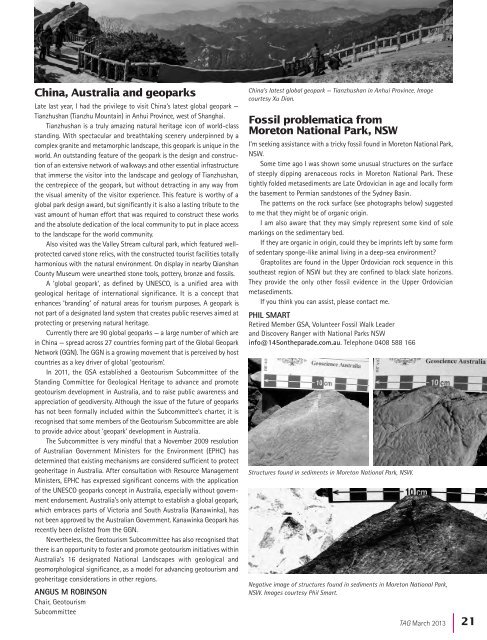TAG 166 - Geological Society of Australia
TAG 166 - Geological Society of Australia
TAG 166 - Geological Society of Australia
You also want an ePaper? Increase the reach of your titles
YUMPU automatically turns print PDFs into web optimized ePapers that Google loves.
China, <strong>Australia</strong> and geoparksLate last year, I had the privilege to visit China’s latest global geopark —Tianzhushan (Tianzhu Mountain) in Anhui Province, west <strong>of</strong> Shanghai.Tianzhushan is a truly amazing natural heritage icon <strong>of</strong> world-classstanding. With spectacular and breathtaking scenery underpinned by acomplex granite and metamorphic landscape, this geopark is unique in theworld. An outstanding feature <strong>of</strong> the geopark is the design and construction<strong>of</strong> an extensive network <strong>of</strong> walkways and other essential infrastructurethat immerse the visitor into the landscape and geology <strong>of</strong> Tianzhushan,the centrepiece <strong>of</strong> the geopark, but without detracting in any way fromthe visual amenity <strong>of</strong> the visitor experience. This feature is worthy <strong>of</strong> aglobal park design award, but significantly it is also a lasting tribute to thevast amount <strong>of</strong> human effort that was required to construct these worksand the absolute dedication <strong>of</strong> the local community to put in place accessto the landscape for the world community.Also visited was the Valley Stream cultural park, which featured wellprotectedcarved stone relics, with the constructed tourist facilities totallyharmonious with the natural environment. On display in nearby QianshanCounty Museum were unearthed stone tools, pottery, bronze and fossils.A ‘global geopark’, as defined by UNESCO, is a unified area withgeological heritage <strong>of</strong> international significance. It is a concept thatenhances ‘branding’ <strong>of</strong> natural areas for tourism purposes. A geopark isnot part <strong>of</strong> a designated land system that creates public reserves aimed atprotecting or preserving natural heritage.Currently there are 90 global geoparks — a large number <strong>of</strong> which arein China — spread across 27 countries forming part <strong>of</strong> the Global GeoparkNetwork (GGN). The GGN is a growing movement that is perceived by hostcountries as a key driver <strong>of</strong> global ‘geotourism’.In 2011, the GSA established a Geotourism Subcommittee <strong>of</strong> theStanding Committee for <strong>Geological</strong> Heritage to advance and promotegeotourism development in <strong>Australia</strong>, and to raise public awareness andappreciation <strong>of</strong> geodiversity. Although the issue <strong>of</strong> the future <strong>of</strong> geoparkshas not been formally included within the Subcommittee’s charter, it isrecognised that some members <strong>of</strong> the Geotourism Subcommittee are ableto provide advice about ‘geopark’ development in <strong>Australia</strong>.The Subcommittee is very mindful that a November 2009 resolution<strong>of</strong> <strong>Australia</strong>n Government Ministers for the Environment (EPHC) hasdetermined that existing mechanisms are considered sufficient to protectgeoheritage in <strong>Australia</strong>. After consultation with Resource ManagementMinisters, EPHC has expressed significant concerns with the application<strong>of</strong> the UNESCO geoparks concept in <strong>Australia</strong>, especially without governmentendorsement. <strong>Australia</strong>’s only attempt to establish a global geopark,which embraces parts <strong>of</strong> Victoria and South <strong>Australia</strong> (Kanawinka), hasnot been approved by the <strong>Australia</strong>n Government. Kanawinka Geopark hasrecently been delisted from the GGN.Nevertheless, the Geotourism Subcommittee has also recognised thatthere is an opportunity to foster and promote geotourism initiatives within<strong>Australia</strong>’s 16 designated National Landscapes with geological andgeomorphological significance, as a model for advancing geotourism andgeoheritage considerations in other regions.ANGUS M ROBINSONChair, GeotourismSubcommitteeChina’s latest global geopark — Tianzhushan in Anhui Province. Imagecourtesy Xu Dian.Fossil problematica fromMoreton National Park, NSWI’m seeking assistance with a tricky fossil found in Moreton National Park,NSW.Some time ago I was shown some unusual structures on the surface<strong>of</strong> steeply dipping arenaceous rocks in Moreton National Park. Thesetightly folded metasediments are Late Ordovician in age and locally formthe basement to Permian sandstones <strong>of</strong> the Sydney Basin.The patterns on the rock surface (see photographs below) suggestedto me that they might be <strong>of</strong> organic origin.I am also aware that they may simply represent some kind <strong>of</strong> solemarkings on the sedimentary bed.If they are organic in origin, could they be imprints left by some form<strong>of</strong> sedentary sponge-like animal living in a deep-sea environment?Graptolites are found in the Upper Ordovician rock sequence in thissoutheast region <strong>of</strong> NSW but they are confined to black slate horizons.They provide the only other fossil evidence in the Upper Ordovicianmetasediments.If you think you can assist, please contact me.PHIL SMARTRetired Member GSA, Volunteer Fossil Walk Leaderand Discovery Ranger with National Parks NSWinfo@145ontheparade.com.au. Telephone 0408 588 <strong>166</strong>Structures found in sediments in Moreton National Park, NSW.Negative image <strong>of</strong> structures found in sediments in Moreton National Park,NSW. Images courtesy Phil Smart.<strong>TAG</strong> March 2013| 21
















